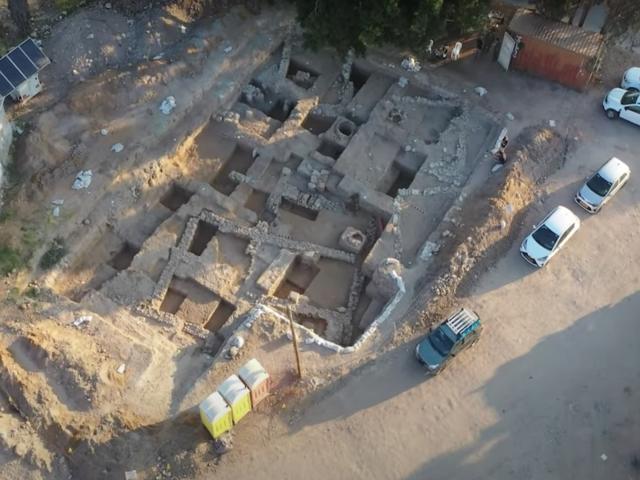The recent unearthing of a hoard of valuable silver and bronze coins beneath a building in Lod, Israel, has provided an astonishing glimpse into the past, revealing the first-ever evidence from Lod of the Gallus Revolt, the final Jewish resistance against Roman rule, dated between 351 and 354 CE.
A Serendipitous Discovery
During routine excavations by the Israel Antiquities Authority (IAA) and the Lod Municipality, a hidden treasure was discovered in the ruins of a Jewish public building on Nordau Street. The coins, dating from 221 to 354 CE, were carefully concealed under the floorboards, seemingly in anticipation of retrieval once peace was restored. This remarkable find not only underscores the tumultuous history of the period but also provides tangible evidence of the last Jewish revolt against Roman domination.
Jews in non-existent Arab "Palestine"
— Yisrael Medad (@ymedad) June 16, 2024
In Lod a public building suffered violent destruction. 94 coins found between 221/354 CE, when Jewish communities such as Lod, Zipori and Tiberias were destroyed by the forces of Ceasar Flavius Constantinus Gallus.https://t.co/xA6a90QKS5 pic.twitter.com/TWcpftID1K
Historical Context
The Gallus Revolt, named after Roman Caesar Flavius Constantinus Gallus, was a significant yet understudied uprising. Historical texts mention the widespread destruction inflicted on major Jewish communities such as Lod, Zipori, and Tiberias by Roman forces. However, written records are scarce, making archaeological discoveries like this one invaluable for understanding the scale and impact of the rebellion.
Rich Archaeological Findings
The excavated building, dating back to the Late Roman-Early Byzantine period, was found to be violently destroyed, its remnants bearing silent witness to the ferocity of the revolt. Among the discoveries were impressive stone and marble artifacts, inscriptions in Greek, Hebrew, and Latin, and a particularly intriguing inscription identifying a Jewish man from a priestly family, which is currently under examination.
The absence of pig bones among the excavated remains further confirms the building's association with the Jewish community. According to IAA site excavators Shahar Krispin and Mor Viezel, "This magnificent Jewish building likely housed the city's elders. Lod was a significant Jewish center after the Second Temple's destruction, as evidenced by Talmudic writings and the presence of renowned sages such as Rabbi Eliezer ben Horkanos, Rabbi Tarfon, Rabbi Akiva, and Rabbi Yosi Ha'Galili."
A horde of bronze and silver coins dating back to the last Jewish rebellion against the Roman empire uncovered in Lod (Lydda).
— Yossi Preminger (@ExoThinker) June 16, 2024
Dated 250 years before Islam.#Israel #Palestine https://t.co/UaQtvKkkVr
A Monumental Revelation
The discovery of this building and its coin hoard is not just an archaeological triumph but also a poignant reminder of the brutal suppression of the Jewish revolt. The building’s destruction down to its very foundations signals the violent end of what was a vibrant and significant Jewish community. This site stands as the sole testament, thus far, to the intensity and scale of the Gallus Revolt in Lod, centrally located in Israel.
Scholarly and Public Enthusiasm
Prof. Joshua Schwartz, head of the IAA council and a scholar of Talmudic period Lod, remarked, "The exact function of this building remains unclear—whether it served as a synagogue, study hall, meeting hall, or all three. What is certain is that its grandeur, combined with the archaeological finds, aligns with historical descriptions of Lod/Diospolis as a center of Jewish life during the Mishna and Talmud periods. This building’s discovery is a testament to Lod’s enduring role as a hub of Torah-true Jewish life until it was cruelly cut short by the Gallus Revolt."
IAA director Eli Escuzido emphasized the importance of preserving Lod's rich heritage: "These impressive finds reinforce our responsibility to explore and conserve Lod’s history. Alongside the city's new exhibition center featuring the beautiful Lod mosaic, we now bring this building to the public’s awareness."
Coins from a 1,650 years ago were discovered in excavations of a destroyed Jewish building in Lod. Experts said they were evidence of the last Jewish revolt against Roman rule in Israel.
— The Jerusalem Post (@Jerusalem_Post) June 16, 2024
✍️Judy Siegel-Itzkovitchhttps://t.co/YbH5ApRu4z
A Future Bridged with the Past
Lod mayor Yair Revivo expressed his excitement, stating, "This discovery is a deeply moving addition to Lod's rich Tannaitic period heritage, showcasing the city’s historical significance as a center for the authors of the Mishna. These finds prove that Lod is one of the oldest continuously inhabited cities in the world. We extend our gratitude to the IAA for unveiling our city’s past glory. This site, now uncovered, is expected to attract many tourists, linking Lod’s ancient heritage with its bright future."
Upcoming Conference
The findings will be presented at the Central Israel Region Archaeological Conference, open to the public, at Tel Aviv’s Eretz Yisrael Museum on June 20. The event, hosted by Tel Aviv University (TAU), Bar-Ilan University, and the IAA, will provide further insights into this extraordinary discovery. More details can be found on the Israel Antiquities Authority website.


